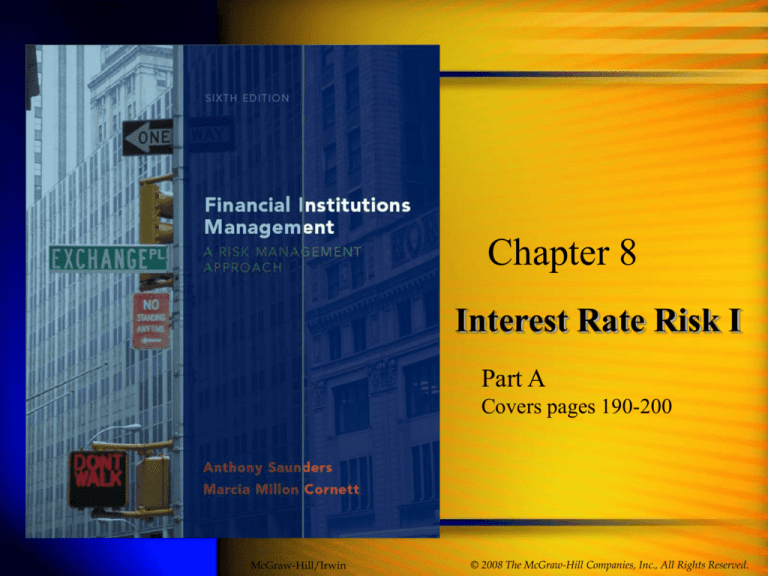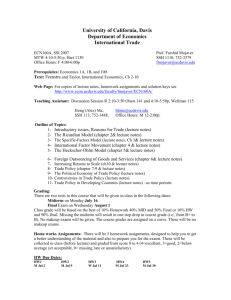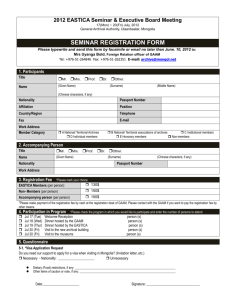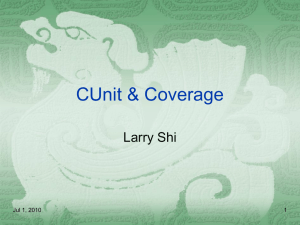
Chapter 8
Interest Rate Risk I
Part A
Covers pages 190-200
McGraw-Hill/Irwin
© 2008 The McGraw-Hill Companies, Inc., All Rights Reserved.
Overview
8-2
This chapter discusses the interest rate risk
associated with financial intermediation:
Federal Reserve monetary policy
Interest rate risk models
*Term structure of interest rate risk
*Theories of the term structure of interest
rates
Interest Rate Risk Models
Repricing model
Maturity model
Duration model
In-house models
Proprietary
Commercial
8-3
Loanable Funds Theory
8-4
Interest rates reflect supply and demand for
loanable funds
Shifts in supply or demand generate interest
rate movements as market forces establish
a new equilibrium
Determination of Equilibrium Interest Rates
8-5
8-6
Note that
y-axis is
bond
PRICE
Increase in Demand for Bonds
8-7
8-8
Factors
that
impact
bond
demand
Bond Supply Shift – Increase in Supply
8-9
8-10
Factors
that
impact
bond
supply
8-11
Level & Movement of Interest Rates
Federal Reserve Bank: U.S. central bank
Open market operations influence money
supply, inflation, and interest rates
Actions of Fed in response to 2001 attacks on
World Trade Center
June 2004- August 2006
Lowered interest rates 11 times during the year
inflation concerns take prominence
17 consecutive increases in interest rates
2008/2009 Short rates lowered to virtually zero
Central Bank and Interest Rates
Target is primarily short term rates
Focus on Fed Funds Rate in particular
Interest rate changes and volatility
increasingly transmitted from country to
country
Statements by Ben Bernanke can have
dramatic effects on world interest rates.
8-12
Fed Funds Rate
20
3Mo CD
15
8-13
Short-Term Rates 1954-2009
25
3 Mo T-bill
10
5
0
08
Jul 06
Jul 04
Jul 02
Jul 00
Jul 98
Jul 96
Jul 94
Jul 92
Jul 90
Jul 88
Jul 86
Jul 84
Jul 82
Jul 80
Jul 78
Jul 76
Jul 74
Jul 72
Jul 70
Jul 68
Jul 66
Jul 64
Jul 62
Jul 60
Jul 58
Jul 56
Jul 54
Jul -
Short-Term Rates 1997-2009
3Mo CD
5
Fed Funds
3Mo T-Bill
6
8-14
8
7
4
3
2
1
0
9
n-0
Ju 9
b-0
Fe 8
t-0
Oc 8
n-0
Ju 8
b-0
Fe 7
t-0
Oc 7
n-0
Ju 7
b-0
Fe 6
t-0
Oc 6
n-0
Ju 6
b-0
Fe 5
t-0
Oc 5
n-0
Ju 5
b-0
Fe 4
t-0
Oc 4
n-0
Ju 4
b-0
Fe 3
t-0
Oc 3
n-0
Ju 3
b-0
Fe 2
t-0
Oc 2
n-0
Ju 2
b-0
Fe 1
t-0
Oc 1
n-0
Ju 1
b-0
Fe 0
t-0
Oc 0
n-0
Ju 0
b-0
Fe 9
t-9
Oc 9
n-9
Ju 9
b-9
Fe 8
t-9
Oc 8
n-9
Ju 8
b-9
Fe 7
t-9
Oc 7
n-9
Ju
Short-Term Rates 2007-2009
3Mo CD
4
Fed Funds
3Mo T-Bill
5
8-15
7
6
3
2
1
0
9
7/0
8/2
9
7/0
7/2 9
7/0
6/2
9
7/0
5/2 9
7/0
4/2
9
7/0
3/2 9
7/0
2/2
9
7/0
1/2
/0 8
/27
12
/0 8
/27
11
/0 8
/27
10
8
7/0
9/2
8
7/0
8/2
8
7/0
7/2
8
7/0
6/2
8
7/0
5/2 8
7/0
4/2
8
7/0
3/2 8
7/0
2/2
8
7/0
1/2
/0 7
/27
12
/0 7
/27
11
/0 7
/27
10
7
7/0
9/2
7
7/0
8/2
7
7/0
7/2
7
7/0
6/2
Rate Changes Can Vary by Market
8-16
Note that there have been significant
differences in recent years
If your asset versus liability rates change by
different amounts, that is called “basis risk”
May not be accounted for in your interest rate
risk model
Repricing Model
8-17
Repricing or funding gap model based on book
value.
Contrasts with market value-based maturity and
duration models recommended by the Bank for
International Settlements (BIS).
Rate sensitivity means time to repricing.
Repricing gap is the difference between the rate
sensitivity of each asset and the rate sensitivity of
each liability: RSA - RSL.
Refinancing risk
However, theoretically could be reinvestment risk
(positive gap)
Repricing Model
8-18
We are interested in the Repricing Model as
an introduction to the importance of Net
Interest Income
Variability of NII is really what we are trying to
protect
NII is the lifeblood of banks/thrifts
Maturity Buckets
Commercial banks must report repricing
gaps for assets and liabilities with maturities
of:
8-19
One day.
More than one day to three months.
More than 3 three months to six months.
More than six months to twelve months.
More than one year to five years.
Over five years.
Note the cut-off levels
Repricing Gap Example
Assets
1-day
$ 20
>1day-3mos.
30
>3mos.-6mos. 70
>6mos.-12mos. 90
>1yr.-5yrs.
40
>5 years
10
Liabilities
$ 30
40
85
70
30
5
Gap Cum. Gap
$-10
$-10
-10
-20
-15
-35
+20
-15
+10
-5
+5
0
8-20
Repricing Gap Example
Assets
1-day
$ 20
>1day-3mos.
30
>3mos.-6mos. 70
>6mos.-12mos. 90
>1yr.-5yrs.
40
>5 years
10
Liabilities
$ 30
40
85
70
30
5
8-21
Gap Cum. Gap
$-10
$-10
-10
-20
-15
-35
+20
-15
+10
-5
+5
0
Note this example is not realistic because asset =
liabilities
Usually assets > liabilities, final CGAP will be +
Applying the Repricing Model
8-22
DNIIi = (GAPi) DRi = (RSAi - RSLi) DRi
Example:
In the one day bucket, gap is -$10 million. If rates
rise by 1%,
DNII(1) = (-$10 million) × .01 = -$100,000.
Applying the Repricing Model
Example II:
If we consider the cumulative 1-year gap,
DNII = (CGAPone year) DR = (-$15 million)(.01)
= -$150,000.
8-23
Rate-Sensitive Assets
8-24
Examples from hypothetical balance sheet:
Short-term consumer loans. If repriced at yearend, would just make one-year cutoff.
Three-month T-bills repriced on maturity every
3 months.
Six-month T-notes repriced on maturity every 6
months.
30-year floating-rate mortgages repriced (rate
reset) every 9 months.
Rate-Sensitive Liabilities
8-25
RSLs bucketed in same manner as RSAs.
Demand deposits and passbook savings
accounts warrant special mention.
Generally considered rate-insensitive (act as
core deposits), but there are arguments for their
inclusion as rate-sensitive liabilities.
FOR NOW, we will treat these as though they
reprice overnight
Text assumes that they do not reprice at all
CGAP Ratio
May be useful to express CGAP in ratio
form as,
CGAP/Assets.
8-26
Provides direction of exposure and
Scale of the exposure.
Example- 12 month CGAP:
CGAP/A = $15 million / $270 million = 0.056, or
5.6 percent.
8-27
Equal Rate Changes on RSAs, RSLs
Example: Suppose rates rise 2% for RSAs
and RSLs. Expected annual change in NII,
DNII = CGAP × D R
= $15 million × .02
= $300,000
With positive CGAP, rates and NII move in
the same direction.
Change proportional to CGAP


![[#STRATOS-256] HTTP 500 page returned if user click on the cloud](http://s3.studylib.net/store/data/007375298_1-8a1d7dac356409f0d3c670b454b6d132-300x300.png)


